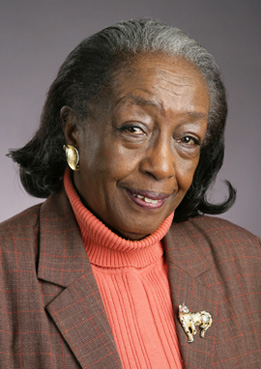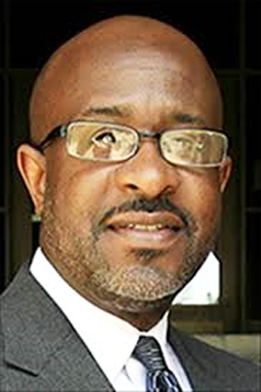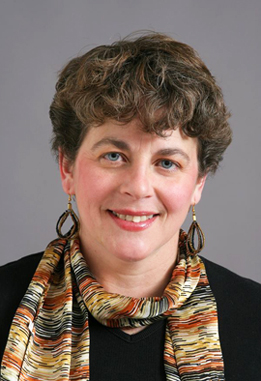|
Cultural
Competence in the Real World of Schools
By Lynne Hamer, Ph.D, and
Willie McKether, Ph.D.
The Truth Contributors
Those readers who have followed our previous articles know
that our agendas for Community Conversations meetings
alternate between highlighting data and research—as in the
school-to-prison pipeline data in our last column—and best
practices. Here, we focus on a best practice—or rather, a
best practitioner with years of teaching experience and
wisdom to share. In Community Conversations, participants
have the too-rare opportunity to listen to elders and learn
from them. One of these elders is Mattie McAlister, who
seldom misses a meeting.
McAlister’s take on what we need for school success is
grounded in her being in public school classrooms for 42
years (she says she spent the first six years learning
to teach effectively, and she actually taught for 36
years), and then having directed Grace Community Center’s
after-school tutoring program for another many years.
She notes that throughout her teaching, she constantly tried
“to find ways to better satisfy the emotional, academic, and
mental needs of each individual in [her] care.” The core of
her insight is simple but seldom heard in public forums:
“Children are fragile, and teachers can break them.” This is
but one example of a “golden nugget” that McAlister
effortlessly drops during our community conversations.
McAlister attributes her career choice and success to her
parents. Asked in one Community Conversation what teacher in
her childhood had most impact on her, McAlister recalled,
“All my teachers were great,” but that her father had had
the greatest impact on her: he was a principal, and
McAlister remembered “how sad he would be when he had to
dismiss a teacher because of her inability to maintain class
control.” As a teacher, she resolved that she would manage
her students’ behavior without aid from the principal and
others.
To do this, she developed positive ways to hold the interest
of her students, without harshness, paddling, or yelling.
McAlister recounts that she only sent one child to the
principal during her entire teaching career. This
eight-year-old equated paddling with love, because her
mother had told her that she whipped her because she loved
her. Thus she wanted Ms. McAlister to paddle her to prove
her love for her.
McAlister describes, “Three days before school’s closing,
she came in knocking over desks and bumping into children in
a final effort to get me to paddle her, and I had no choice
other than removing her from the class.” McAlister’s advice
to parents? “Never tell a child you whip them because you
love them. Children may not properly interpret your
meaning.”
|

Mattie McAlister

Willie McKether

Lynne Hamer |
|
Memories of herself as a young student in South Carolina
have influenced McAlister’s teaching philosophy as well. She
recalls that as a very busy three-year-old, home with her
mother day in and day out, one day her mother said to her
father, “Take this child to school with you. I can’t stand
it!” McAlister recalls, “That hurt,” but also that going to
school was her greatest desire.
She was already reading and “meddling” with her older
siblings as they completed homework. At her father’s school,
“Miss Sadie allowed me to sit with her first-grade
children.” At first, Miss Sadie called me ‘honey,’ or
‘darling,’ or ‘sweetie,’ but soon she was calling me Mattie,
and soon she was elevating her voice when she told me to sit
down. I lasted about three weeks, I’m told.” She laughs.
“I quit school when she threatened to whip me. I had seen
her whip a child, and I didn’t want one of those things! I
became a less pesky child at home for fear I’d be sent back
to Miss Sadie’s room.”
She recalls always being a “nuisance and busy body in
school,” and having to “run home to avoid being tackled by
children [she] had corrected or remarked about their
inability to correctly complete school work.” She recalls it
was difficult to “sit down, and what a strain it was to
wait for the teacher to stop talking and let us do the
work,” and describes herself as “as innocently busy, as
innocently nosy, and as politely disruptive as any so called
‘hyper’ child.”
She feels lucky that teachers for the most part worked
with her and not against her, and she learned from her own
experiences to understand aberrant behavior in children. “I
sought to learn why children behaved as they did, and I
worked hard to bring about positive changes in their
behavior,” she stated. This is what we mean by being a
culturally-competent teacher.
In conversations about reducing disciplinary actions that
contribute to the school-to-prison pipeline, McAlister has
contributed her own action research, conducted formally and
informally over the years. She has developed the Summer
Birthday Theory, noting that children who are born in the
summer will be nine to 12 months younger than their
classmates. They will have more immature behaviors because,
physically, mentally, and emotionally, they are more
immature.
Her recommendation? Teachers should chart their students’
birthdays and have appropriate expectations for different
behaviors based on age. She claims that too many “summer
babies” have been labeled as “slow learners” or as having
emotional or behavioral disorders, when “their only problem
was they were too young to perform in school as well as
their older classmates.” Again, culturally-competent
teaching in involves searching out the reason behind the
behavior.
The Monday evening meetings are not the only venue in which
McAlister shares her experience. Last November, McAlister
shared her wisdom with future teachers—University of Toledo
undergraduate teacher education students. Nuggets of wisdom
included:
·
Teachers should always greet students and put the students’
feelings first by putting their students at ease.
McAlister recalled how she always stood outside her
classroom to greet her students as they entered. She
particularly remembered a student with a perpetual nose.
Instead of asking that student of he wanted a Kleenex the
moment he entered the classroom, McAlister would always
greet him, wait until he was settled, and then nicely and
privately offer a tissue, so the student wouldn’t feel
self-conscious or embarrassed. She emphasized, “Never
make a correction in the hearing of the entire class. Find a
way to correct the child privately.”
·
Teachers should find a way to present with humor. McAlister modeled this
throughout her presentation to the future teachers. When
leading them in a “Silent Sustained Writing” prompt, which
she advocated using to give students something to do before
class starts and to allow the teacher to do a quick check-in
with them, she instructed the college students, “Eenie,
meenie, miney—go!”—and they immediately started the
six minutes of silent writing. In discussing the exercise,
she pointed out, “If you can get your students’ attention,
you can keep it.”
·
Teachers should talk less and learn to moderate their
voices. McAlister noted that a
teacher talking too much “makes the children nervous.” She
advocated getting the children working, then going around
the room to work with individuals. Most important, teachers
should never yell, “Shut up,” and should not talk too loudly
or too fast. Teachers who normally have high voices need to
work on lowering their voices, doing exercises and getting
coaching as needed. She calls “voice control” one of the
best controls a teacher can use.
·
Teachers should resist jumping to conclusions and
disciplinary action, but should listen to learn why children
do what they do. McAlister told about an
eight-year-old boy who lived so close to the school that he
could see his house from the classroom window. He always
got up randomly and stood by the window in class. She didn’t
know why and found it distracting, but instead of punishing
him, she asked his parents about it. She learned he had
witnessed a shooting outside his home window, and he
therefore stood at the window as a “protector.”
·
Teachers should make fewer correctives, and always consider
for whom a behavior is a problem.
McAlister recalled, “I don’t give a flying banana if a child
is sitting up straight,” and gave an example: “I had a boy
who learned leaning over his desk and constantly swinging
his arm. It was such a distraction—I wanted to kill him!”
Instead, she contracted with him to sit in the back of the
room where he could swing his arm without it bothering her
and the other students, because he learned best when he was
doing so. “By year’s end, he was finally able to function
without leaning on his desk and swinging his arm.”
·
Teachers should consistently check their students’ mastery
of skills.
McAlister developed a daily test, “The Five Game,” to see if
all students can correctly add, subtract, multiply, and
divide, with five problems, done by everyone, at the
beginning of the day. The game always contained two or three
“self-esteem building problems,” that is, problems all could
do correctly, as well as others to find out what skills
needed reinforcement. Using this method, a teacher knows if
a student is having trouble with a key skill and can help
her/him, privately and immediately. McAlister noted,
“Repetitive learning brings mastery.”
·
Teachers and administrators must recognize the power of
their own behavior and how both their own prejudices and
their students’ prejudices influence it.
McAlister urged teachers to be careful not to let their
beliefs about a child’s background or looks creep unnoticed
into how they treat that child. She admonished, “In today’s
world, we have children damaged in school by their teachers’
prejudices. And we have teachers who are being damaged by
their children’s prejudices. If you become parents, don’t
let your children ever hear your prejudices, because they’ll
go into school and act out those prejudices, only to land in
trouble.” She noted that white teachers will have black
students who have learned from talk at home to believe that
white people hate them. In contrast, black teachers will
have white students who have learned from their parents that
black people, including black teachers, are stupid and
inferior. “We have created a society of very fragile
children and fragile teachers,” she concluded. Teachers
have to deal with their own frailties so they can focus on
the children to build their strengths.
Back at Community Conversations, McAlister summed up the
importance of cultural competence: “People who are going to
work with children must have strong knowledge of the
cultural backgrounds that children come from. Not all black
children have had the same experiences, nor have all white,
or all Mexican. You can’t put teachers in the classroom
until they know this, or it will be a disaster. Many
potentially great teachers have failed because they did not
understand or appreciate the cultures of their students.”
We honor and acknowledge Mattie McAlister as well as all
retired TPS teachers for their service and willingness to
mentor today’s educators as well as the community as a
whole. Our learning continues.
The authors of this column are on the faculty at the
University of Toledo and facilitate the group “Community
Conversations for School Success.” Lynne Hamer is professor
of Educational Foundations and Leadership and directs UT@TPS,
and Willie McKether is associate dean in the College of
Language, Literature and Social Science and Associate
Professor of Sociology/Anthropology. Everyone is welcome to
join in the Community Conversations, which take place the
first and third Mondays of every month, 6:30-8:00 pm, at the
Kent Branch of the public library. Our next conversation is
March 16. For more information or to get on our email list,
please contact Lynne Hamer, 419-283-8288,
lynne.hamer@utoledo.edu, or Willie McKether,
419-309-4931,
willie.mckether@utoledo.edu.
|